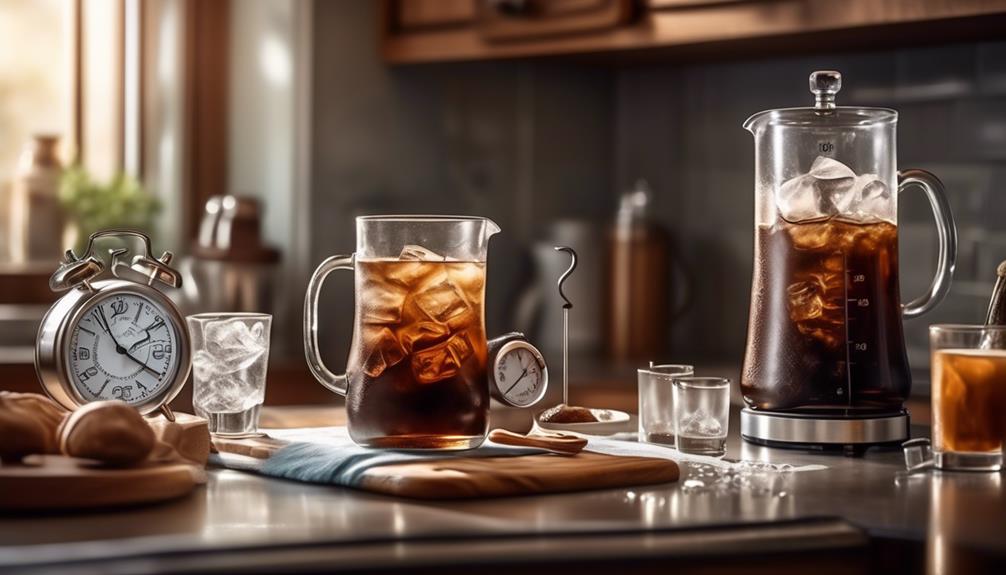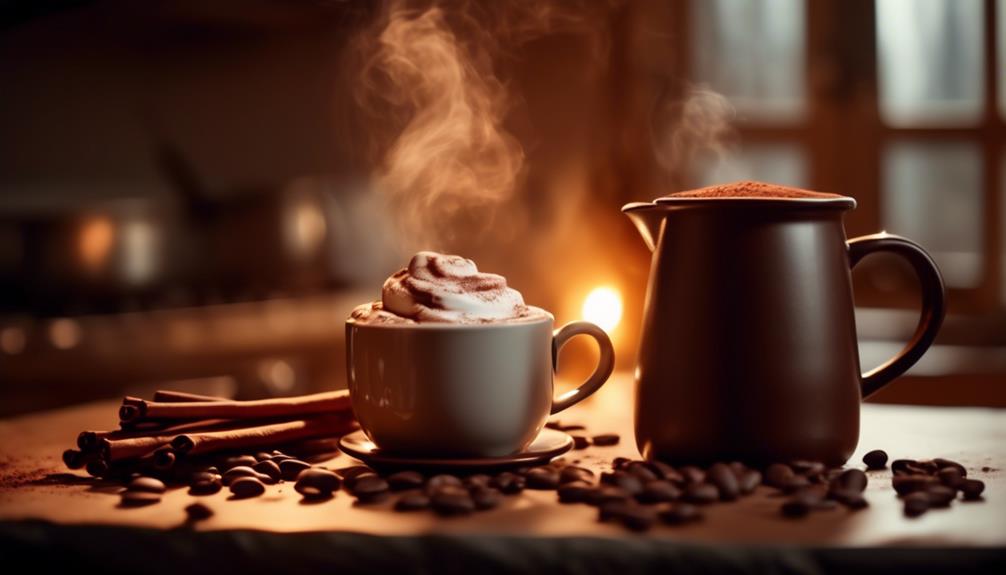How to Make Large Batch Cold Brew Coffee?

Just as a painter needs a broad canvas to create a masterpiece, you need a large batch of cold brew to satisfy an insatiable thirst for coffee. You’re stepping into a realm where the usual single-cup brew method won’t suffice; it’s time to think big.
How to make large batch cold brew coffee? Starting with the selection of beans, moving on to the right equipment, and nailing the perfect coffee-to-water ratio, there’s an art and science to crafting the perfect large batch of cold brew coffee. The process, from steeping time to filtration techniques, requires a keen eye for detail and a bit of patience.
But before you get lost in the specifics of beans and brew times, let’s consider why mastering this craft is worth your while, especially when it comes to serving a crowd or just ensuring your fridge is always stocked with your favorite chilled beverage.
Key Takeaways
- Select high-quality coffee beans from craft coffee roasters for flavorful cold brew.
- Use a coarse grind of coffee beans to prevent over-extraction and bitterness.
- Brew the cold brew for 18 to 24 hours for optimal flavor extraction.
- Properly filter the cold brew using a chinois strainer and cheesecloth for a clear and smooth concentrate.
Read: How to Make Coconut Water at Home?
Selecting Your Coffee Beans

Choosing the right coffee beans is a crucial step in crafting a flavorful and aromatic cold brew, as the quality and roast of the beans significantly influence the final taste. When you’re selecting your coffee beans, it’s essential to seek out high-quality beans from craft coffee roasters. These artisans can guide you on roast levels and help you pick the right bean and flavor profile for your cold brew. A medium roast is often preferred for its balanced flavor, but don’t hesitate to explore based on your taste preferences.
Opting for whole coffee beans and grinding them to a coarse coffee grounds consistency is key. Coarse ground coffee is ideal for cold brew’s brewing method, as it keeps the grounds contained in the filter bag and prevents over-extraction, ensuring a smooth, rich flavor without bitterness. The coffee grind plays a pivotal role in the coffee to water ratio, influencing the strength and taste of your brew.
Essential Equipment Needed

How to make large batch cold brew coffee? To kick off your large batch cold brew journey, you’ll need to gather a few essential pieces of equipment that are key to achieving that perfectly smooth and richly flavored brew.
- First and foremost, a 22-quart container is indispensable for steeping your cold brew. This container needs to be large enough to accommodate the higher ratio of coffee to cold filtered water, which is crucial for extracting the full depth of flavor without dilution.
- Next, you’ll require a chinois strainer and cheesecloth for filtering. These tools work together to ensure your batch of cold brew is free from coffee grounds, resulting in a clean, crisp taste. The strainer efficiently separates the bulk of the grounds from the liquid, while the cheesecloth catches any remaining fine particles.
- Additionally, a coarse mesh filter bag can be incredibly useful for containing the coffee grounds during the steeping process. This simplifies cleanup and makes it easier to strain the mixture once brewing is complete.
- Lastly, don’t forget a large pitcher or storage container for the finished cold brew. It should be airtight to preserve the freshness and rich flavor of your coffee until you’re ready to enjoy it.
With this essential equipment in hand, you’re well on your way to mastering large batch cold brew coffee.
Read: What Are Popular Iced Coffee Drinks?
Coffee-to-Water Ratios

Remember, it is crucial to nail down the perfect coffee-to-water ratio, a fundamental step that significantly influences the brew’s strength and flavor profile. Whether you’re making a couple of cups or several gallons of cold brew, the ratio of coffee to cold water plays a critical role in defining the resultant brew’s concentration and taste.
Here are some essential tips for making cold brew coffee:
- Start with a basic ratio of 1 ounce of ground coffee per cup of water for smaller batches. This ensures a balanced strength that’s neither too weak nor overpoweringly strong.
- For large batches, shift to a ratio of 1 pound of ground coffee to 1.75 gallons of water. This scale-up maintains the flavor consistency across larger volumes.
- Adjust the ratio based on personal preference for strength and flavor. If you prefer a stronger brew, increase the coffee; for a lighter brew, increase the water.
- Experiment with different coffee-to-water ratios to find the perfect balance that suits your taste. Remember, the goal is to brew cold coffee that you love.
Brewing Time and Temperature

Mastering the art of cold brew coffee requires precise control over brewing time and temperature, elements that significantly impact the final cup’s smoothness and acidity. When you decide to make a big batch of cold brew, understanding these factors becomes even more critical to ensure every sip is perfect.
For a Large Batch Cold Brew, the golden rule is to let it sit for 18 to 24 hours, allowing the coffee to steep in cold or room temperature water. This extended period is vital for achieving the optimal flavor extraction that cold brew is renowned for.
Utilizing colder water, preferably cold or room temperature, is crucial as it prevents the coffee from becoming bitter—a common pitfall when heat is introduced. The magic of cold brew lies in its brewing time and temperature; longer times and colder temperatures yield a batch of coffee that’s remarkably smooth and less acidic.
To maintain consistency, especially when brewing a Big Batch Cold Brew, consider using a refrigerator. This provides a controlled environment, ensuring your cold brew concentrate remains unexposed to heat, preserving its delicate flavors.
Read: Best Summer Drinks Starbucks
Filtration Techniques

Once you’ve allowed your large batch cold brew to steep for the optimal 18 to 24 hours, achieving a smooth and sediment-free concentrate hinges on your filtration technique.
The process of making large batches of cold brew coffee might seem daunting, but with the right filtration techniques, it’s surprisingly easy to make a deliciously clear concentrate.
Here’s how you can ensure your Batch Cold Brew Coffee turns out perfect every time:
- Use a chinois strainer and cheesecloth: This duo is your best bet for removing both large grounds and finer particles.
- Pour through the chinois first: This step catches the larger coffee grounds, significantly reducing the amount of sediment in your mixture.
- Follow with a cheesecloth strain: To capture those pesky smaller particles, pour the mixture through a cheesecloth. It’s a crucial step for that silky-smooth texture.
- Extract maximum liquid by gently pressing: Don’t waste a drop! Gently press the grounds collected in both the chinois and cheesecloth to squeeze out every bit of flavorful coffee.
Serving and Storage Tips

Once you’ve nailed the perfect recipe, using a specific amount of cold cups of water to make cold brew that’s both robust and smooth, the next steps are vital to maintain that perfection.
Firstly, store your cold brew coffee in a sealed container within the refrigerator. This simple yet effective storage tip safeguards your coffee against staleness and preserves its vibrant flavors.
When it’s time to serve, the art of dilution comes into play. Depending on your preference for strength and flavor, gently mix the cold brew concentrate with water or milk.
For those hot summer days, nothing beats the classic iced coffee. Just pour your cold brew over ice and top it with cold filtered water for an instant refreshment.


